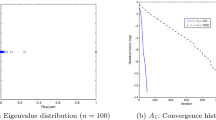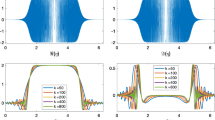Abstract
In this paper, Newmark time-stepping scheme and edge elements are used to numerically solve the time-dependent scattering problem in a three-dimensional cavity. Finite element methods based on the variational formulation derived in [23] are considered. Due to the lack of regularity ofεr, the existence and uniqueness of the discrete solutions and their convergence are proved by using the concept of collectively compact operators. An optimal convergence rate in the energy norm is also established.
Similar content being viewed by others
References
T. Abboud and T. Sayah, Potentiels retardés pour les obstacles homogènes par morceaux, Rapport interne au CMAP, École Polytechnique (1998).
A. Alonso and A. Valli, An optimal domain decomposition preconditioner for low-frequency timeharmonic Maxwell’s equations, Math. Comp. 68 (1999) 607–631.
H. Ammari, G. Bao and A. Wood, Analysis of the electromagnetic scattering from a cavity, Japan J. Industr. Appl. Math. 19 (2001) 301–308.
H. Ammari, G. Bao and A. Wood, A cavity problem for Maxwell’s equations, Methods Math. Appl., to appear.
C. Amrouche, C. Bernardi, M. Dauge and V. Girault, Vector potentials in three-dimensional non-smooth domains, Math. Methods Appl. Sci. 21 (1998).
S. Caorsi, P. Fernandes and M. Raffetto, On the convergence of Galerkin finite element approximations of electromagnetic eigenproblems, SIAM J. Numer. Anal. 38 (2000) 580–607.
Z. Chen, Q. Du and J. Zou, Finite element methods with matching and nonmatching meshes for Maxwell’s equations with discontinuous coefficients, SIAM J. Numer. Anal. 37 (2000) 1542–1570.
P. Ciarlet and J. Zou, Fully discrete finite element approaches for time-dependent Maxwell’s equations, Numer. Math. 82 (1999) 193–219.
M. Costabel, A coercive bilinear form for Maxwell’s equations, J. Math. Anal. Appl. 157 (1991) 527–541.
M. Costabel and M. Dauge, Singularities of electromagnetic fields in polyhedral domains, Technical Report, IRMAR, Universitá de Rennes 1, France (1997); available at http://www.maths.univrennes1.fr/∼costabel/.
M. Eller, V. Isakov, G. Nakamura and D. Tataru,Uniqueness and Stability in the Cauchy Problem for Maxwell’s and Elasticity Systems, eds. D. Cioranescu and J. L. Lions, College de France Seminar, Research Notes in Mathematics, Vol. 14 (Chapman & Hill/CRC, New York) to appear.
V. Girault and P.A. Raviart,Finite Element Methods for Navier-Stokes Equations. Theory and Algorithms (Springer, New York, 1986).
D. Givoli, Non reflecting boundary conditions, J. Comput. Phys. 94 (1991) 1–29.
C. Hazard and M. Lenoir, On the solution of time-harmonic scattering problems for Maxwell’s equations, SIAM J. Math. Anal. 27 (1996) 1597–1630.
F. Kikuchi, On a discrete compactness property for the Nédélec finite elements, J. Fac. Sci. Univ. Tokyo, Sect. IA Math. 36 (1989) 479–490.
A. Kirsch and P. Monk, A finite element method for approximating electro-magnetic scattering from a conducting object, Preprint (2000).
K.S. Komisarek, N.N. Wang, A.K. Dominek and R. Hann, An investigation of new FETD/ABC methods of computation of scattering from three-dimensional material objects, IEEE Trans. Antennas Propagation 47 (1999) 1579–1585.
R. Kress,Linear Integral Equations, 2nd ed. (Springer, New York, 1999).
P. Monk, Analysis of a finite element method for Maxwell’s equations, SIAM J. Numer. Anal. 29 (1992) 714–729.
P.B. Monk, A mixed method for approximating Maxwell’s equations, SIAM J. Numer. Anal. 28 (1991) 1610–1634.
J.C. Nédélec, Mixed finite elements in ℝ3, Numer. Math. 35 (1980) 315–341.
M. Taylor,Pseudodifferential Operators and Nonlinear PDE (Birkhäuser, Boston, 1991).
T. Van and A. Wood, Analysis of time-domain Maxwell’s equations for 3-D electromagnetic cavities, Adv. Comput. Math. 16 (2002) 211–228.
T. Van and A. Wood, A time-domain finite element method for 2-D cavities, J. Comput. Phys. 183 (2002) 486–507.
T. Van and A. Wood, A time-marching finite element method for an electromagnetic scattering problem, Methods Math. Appl., to appear.
V. Vogelsang, On the strong unique continuation principle for inequalities of Maxwell type, Math. Ann. 289 (1991) 285–295.
C. Weber, Regularity theorems for Maxwell’s equations, Math. Methods Appl. Sci. 3 (1981) 523–536.
Author information
Authors and Affiliations
Additional information
Communicated by C.A. Micchelli
Rights and permissions
About this article
Cite this article
Van, T., Wood, A. Finite element analysis of transient electromagnetic scattering problems. Adv Comput Math 22, 21–48 (2005). https://doi.org/10.1007/s10444-005-1176-x
Received:
Accepted:
Published:
Issue Date:
DOI: https://doi.org/10.1007/s10444-005-1176-x




